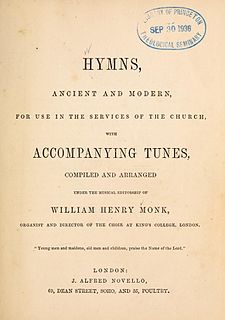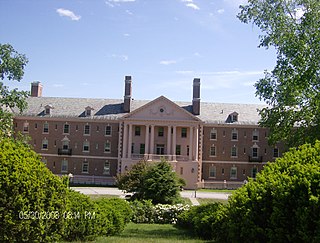Related Research Articles

The Church of Christ, Scientist was founded in 1879 in Boston, Massachusetts, by Mary Baker Eddy, author of Science and Health with Key to the Scriptures, and founder of Christian Science. The church was founded "to commemorate the word and works of Christ Jesus" and "reinstate primitive Christianity and its lost element of healing". Sunday services are held throughout the year and weekly testimony meetings are held on Wednesday evenings, where following brief readings from the Bible and the Christian Science textbook, those in attendance are invited to give testimonies of healing brought about through Christian Science prayer.

Science and Health with Key to the Scriptures is, along with the Bible, the central text of the Christian Science religion. Mary Baker Eddy described it as her "most important work." She began writing it in February 1872 and the first edition was published in 1875. However, she would continue working on it and making changes for the rest of her life.

Mary Baker Eddy was an American religious leader and author who founded The Church of Christ, Scientist, in New England in 1879. She also founded The Christian Science Monitor, a Pulitzer Prize-winning secular newspaper, in 1908, and three religious magazines: the Christian Science Sentinel, The Christian Science Journal, and The Herald of Christian Science. She wrote numerous books and articles, the most notable of which was Science and Health with Key to the Scriptures, which had sold over nine million copies as of 2001.

Christian Science is a set of beliefs and practices associated with members of The First Church of Christ, Scientist. Adherents are commonly known as Christian Scientists or students of Christian Science, and the church is sometimes informally known as the Christian Science church. It was founded in 19th-century New England by Mary Baker Eddy, who wrote the 1875 book Science and Health with Key to the Scriptures, which outlined the theology of Christian Science. The book became Christian Science's central text, along with the Bible, and by 2001 had sold over nine million copies.

A hymnal or hymnary is a collection of hymns, usually in the form of a book, called a hymnbook. Hymnals are used in congregational singing. A hymnal may contain only hymn texts ; written melodies are extra, and more recently harmony parts have also been provided.

"Love Divine, All Loves Excelling" is a Christian hymn by Charles Wesley on Christian perfection. Judging by general repute, it is among Wesley's finest: "justly famous and beloved, better known than almost any other hymn of Charles Wesley." Judging by its distribution, it is also among his most successful: by the end of the 19th century, it is found in 15 of the 17 hymn books consulted by the authors of Lyric Studies. On a larger scale, it is found almost universally in general collections of the past century, including not only Methodist and Anglican hymn books and commercial and ecumenical collections, but also hymnals published by Reformed, Presbyterian, Baptist, Brethren, Seventh-day Adventist, Lutheran, Congregationalist, Pentecostal, and Roman Catholic traditions, among others including the Churches of Christ. Specifically, it appears in 1,328 of the North American hymnals indexed by the online Dictionary of North American Hymnology, comparable to Newton's "Amazing Grace" (1,036), Wesley's "O for a Thousand Tongues" (1,249), and Watts' "When I Survey the Wondrous Cross" (1,483), though still well short of Toplady's "Rock of Ages" (2,139) or Wesley's own "Jesu, Lover of my Soul" (2,164).
Kingdom songs are the hymns sung by Jehovah's Witnesses at their religious meetings. Since 1879, the Watch Tower Society has published hymnal lyrics; by the 1920s they had published hundreds of adapted and original songs, and by the 1930s they referred to these as "Kingdom songs" in reference to God's Kingdom.

Septimus James Hanna, an American Civil War veteran and a judge in the Old West. He was a student of Mary Baker Eddy, who founded the Christian Science church. Giving up his legal career, he became a Christian Science practitioner, lecturer and teacher. Hanna occupied more leading positions within the church organization than any individual, serving as pastor, then First Reader of The Mother Church, as editor and associate editor of the periodicals, member of the Bible Lesson Committee, he served two terms as president of The Mother Church, he was teacher of the Normal (teachers) Class of 1907, later vice president and then president of the Massachusetts Metaphysical College.

The Massachusetts Metaphysical College was founded in 1881 by Mary Baker Eddy in Boston, Massachusetts, to teach her school of Christian Science metaphysical healing that she named Christian Science. Eddy records in the preface of Science and Health with Key to the Scriptures, her chief work on Scientific Christian healing, p. xi, that the college was opened, "under the seal of the Commonwealth, of Massachusetts, a law relative to colleges having been passed which enabled her to get this institution chartered for medical purposes." and it was located at 571 Columbus Avenue, Boston. USA. After teaching for almost seven years, Eddy closed this college in 1889 in order to devote herself to the revision of her book, Science and Health, but retained her charter and reopened the College in 1899 as an auxiliary to her Church.

Hymns Ancient and Modern is a hymnal in common use within the Church of England, a result of the efforts of the Oxford Movement. Over the years it has grown into a large family of hymnals.

The Dupee Estate, located at 400 Beacon Street in the village of Chestnut Hill, Newton, Massachusetts, was the last home of Mary Baker Eddy, the founder of Christian Science.
The Lutheran Hymnal with Supplement is the second official hymnal of the Lutheran Church of Australia, first published in its present form in 1989.

The Pleasant View Home is an historic senior citizen residential facility located at 227 Pleasant Street in Concord, New Hampshire, in the United States. On September 19, 1984, it was added to the National Register of Historic Places.

Christian Worship: A Lutheran Hymnal (CW) is a hymnal of the Wisconsin Evangelical Lutheran Synod (WELS). It was prepared by the WELS Commission on Worship and published by Northwestern Publishing House, the official publisher of the WELS. Christian Worship was intended to succeed The Lutheran Hymnal (TLH) as the common hymnal of the WELS. In 2008, the Christian Worship Supplement (CWS) was released, containing several new orders of service, psalms, and hymns.

The Life of Mary Baker G. Eddy and the History of Christian Science (1909) is a highly critical account of the life of Mary Baker Eddy, the founder of Christian Science, and the early history of the Christian Science church in 19th-century New England. It was published as a book in November 1909 in New York by Doubleday, Page & Company. The original byline was that of a journalist, Georgine Milmine, but a 1993 printing of the book declared that novelist Willa Cather was the principal author; however, this assessment has been questioned by more recent scholarship which again identifies Milmine as the primary author, although Cather and others did significant editing. Cather herself usually wrote that she did nothing more than standard copy-editing, but sometimes that she was the primary author.

Rev. Irving Clinton Tomlinson was an American Universalist minister who converted to Christian Science, becoming a practitioner and teacher. For a time, he lived as one of the workers in the household of church founder, Mary Baker Eddy, later writing a book about his experiences called Twelve Years with Mary Baker Eddy.

Sibyl Wilbur O'Brien Stone, best known as Sibyl Wilbur, was an American journalist, suffragist, and author of a biography of Mary Baker Eddy. She was a San Diego Branch Member of the National League of American Pen Women and a member of the New England Woman's Press Association.

Violet Spiller Hay was a Christian Science teacher and hymnist. She was one of the first teachers of Christian Science in the United Kingdom and the religion's first teacher in South Africa.
References
- ↑ Jackson, George Pullen (1953). Spiritual folk songs of early America. Locust Valley, N.Y.: J.J. Augustine. p. 22.
- ↑ Lovelace, Austin C. (1981). The organist and hymn playing. Carol Stream, I.L.: Agape. pp. 22–23. ISBN 9780916642167.
- ↑ “What’s the background on Eddy’s poems that are set to music in the Christian Science Hymnal?” Mary Baker Eddy Library. 12 December 2011
- 1 2 The Christian Science Hymnal Longyear Museum. 24 April 2014
- ↑ Lyman F. Brackett hymnary.org
- ↑ Christian Science Hymnal. Boston: Christian Science Publishing Society. 1895. p. i.
- 1 2 Did Mary Baker Eddy approve all the selections in the 1932 “Christian Science Hymnal”? Mary Baker Eddy Library. 26 October 2017
- ↑ We Knew Mary Baker Eddy v. II. Boston: Christian Science Publishing Society. 2013. p. 556.
- ↑ Hodgson, Peter J. (2005). Violet Hay. Chestnut Hill, M.A.: Longyear Museum Press. pp. 33, 39.
- ↑ Christian Science Hymnal. Boston: Christian Science Publishing Society. 1932. p. v.
- ↑ The Christian Science Hymnal. Boston: Christian Science Publishing Society. 1910. p. iii.
- ↑ "Announcing the Christian Science Hymnal: Hymns 430–603". 19 May 2017.